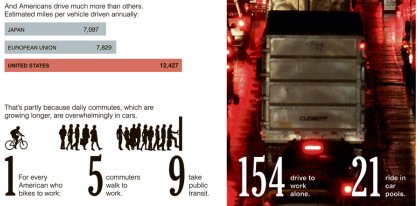Looking at addiction to oil as an epidemic and responding appropriately

U.S. Transportation behavior. Excerpt from a New York Times graphic created by Bill Marsh. Graphic in full size.
The article "The Big Thirst" in the Week in Review section of the New York Times discusses the price of oil and the ever increasing demand for oil in China and India. From the article:
Today’s tensions are only likely to get worse in coming years. Consider a few numbers: The planet’s population is expected to grow by 50 percent to nine billion by sometime in the middle of the century. The number of cars and trucks is projected to double in 30 years— to more than two billion — as developing nations rapidly modernize. And twice as many passenger jetliners, more than 36,000, will in all likelihood be crisscrossing the skies in 20 years.
All of that will require a lot more oil — enough that global oil consumption will jump by some 35 percent by the year 2030, according to the International Energy Agency, a leading global energy forecaster for the United States and other developed nations. For producers it will mean somehow finding and pumping an additional 11 billion barrels of oil every year.
If you believe that there is a finite supply of oil, then this idea that 35% more oil can be produced seems a bit far out. From the article:
The United States is the only major industrialized nation to see its oil consumption surge since the oil shocks of the 1970s and 1980s. This can partly be explained by the fact that the United States has some of the lowest gasoline prices in the world, the least fuel-efficient cars on the roads, the lowest energy taxes, and the longest daily commutes of any industrialized nation. The result: about a quarter of the world’s oil goes to the United States every day, and of that, more than half goes to its cars and trucks.
Even so, AP articles like this, "Gas guzzlers are a big hit in China: Newly affluent want larger SUVs to fill with state-regulated $2.90 gas," are a bit worrisome.
Clearly China has learned from the U.S. in terms of formulating undifferentiated policies that encourage the wrong kinds of decisions. From the article:
Buyers of [SUVs] have also been unintended beneficiaries of a government policy meant to help the poor. Beijing has tried to shield farmers and the urban poor from high oil prices by freezing pump prices for gasoline and diesel, keeping them among the world's lowest. That takes the sting out of filling up a gas guzzler.
Gas costs 5.34 yuan (76 cents) a liter or 20.5 yuan ($2.90) a gallon. State oil companies are barred from passing on rising crude costs to consumers, instead covering their losses out of profits from their drilling units.
How many of China's "urban poor" even have cars and use gasoline? Provide rebates to farmers if that's part of policy, but don't set prices artificially low. The U.S. has proved that is counter productive.
Yesterday, NPR ran this story, focused on the Washington region, "Home Prices Drop Most in Areas with Long Commute." According to the New York Times article, 12.5% of daily world oil production is used for U.S. cars and trucks, and if the amount of miles driven could be reduced by 25%, this would reduce world oil consumption by 3%.
The way to respond to an epidemic is to treat it. Japan and countries in Europe have treated the epidemic by including very high gasoline excise taxes to increase the price significantly, registration fees are higher, and the process for getting a drivers license is more onerous and much more expensive too. In the U.S., prominent politicians including presidential candidate John McCain suggest suspending gasoline excise taxes because of the "high cost" of gasoline, which is but half of the prevailing price in Europe.
Labels: car culture, energy, sustainable land use and resource planning, urban vs. suburban



0 Comments:
Post a Comment
<< Home